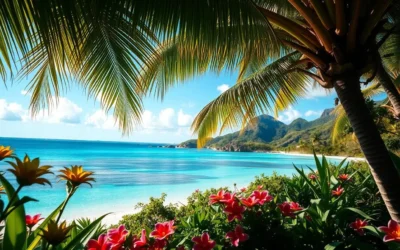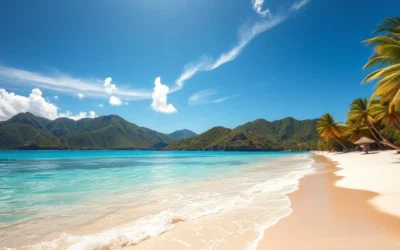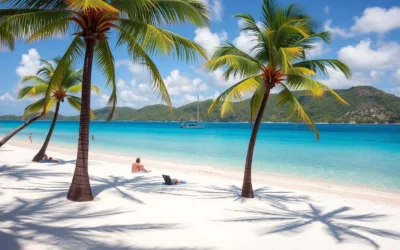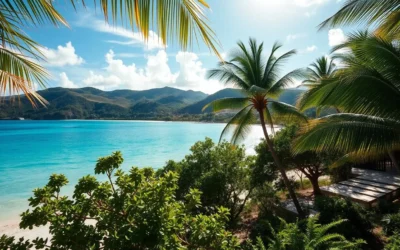✓ Accommodations✓ Flights✓ Rental Cars
Did you know that the U.S. Virgin Islands attract over 2 million visitors annually, with most flocking to its pristine beaches and crystal-clear waters? The key to a perfect Caribbean getaway lies in timing your visit right.
You’ll discover that the islands offer a tropical paradise experience year-round, but certain months provide ideal conditions for different types of travelers and activities. For instance, the period from mid-April to June is considered one of the best times to visit as the dry season ends, and hotel rates drop.
Understanding the seasonal weather patterns is crucial for planning your trip. By doing so, you’ll be able to enjoy perfect beach days, water sports, and budget-friendly options, making your vacation truly unforgettable.
Understanding the USVI Climate
Understanding the climate of the U.S. Virgin Islands is crucial for planning a weather-savvy trip. The Virgin Islands ranks in the 37th percentile for lovely weather compared to other tourist destinations globally.
Year-Round Weather Patterns
The U.S. Virgin Islands enjoy a tropical climate, with daytime temperatures ranging from 84°F in winter to 89°F in summer. Nighttime temperatures vary from 70°F to 76°F, respectively. This consistent temperature pattern means that you can expect warm weather throughout the year.

The Influence of Trade Winds
The trade winds play a significant role in moderating the island climate. During summer, gentle breezes of 5-10 knots are common, while in winter, the winds strengthen to 10-20+ knots, with gusts sometimes exceeding 30 knots.
Humidity and Heat Considerations
The phrase “It’s not the heat; it’s the humidity” is particularly relevant in the USVI, where high humidity can make the temperature feel much hotter. July is the most humid month with 76.2% RH, while February is the least humid at 66.1% RH. Understanding these humidity fluctuations can help you plan your trip more effectively.
By grasping the year-round weather patterns, the influence of trade winds, and humidity considerations, you can make informed decisions about the best time to visit the U.S. Virgin Islands.
U.S. Virgin Islands: Best Months for a Weather-Savvy Trip
When planning a trip to the U.S. Virgin Islands, timing is everything to ensure a weather-savvy vacation. The islands offer a tropical paradise experience, with various periods providing different advantages.
Prime Weather Window: December to April
The prime weather window in the U.S. Virgin Islands is from December to April, characterized by sunny skies, low humidity, and minimal rainfall. This period is ideal for beach activities and outdoor adventures. The mild weather conditions make it the peak tourist season, with January 22nd to April 15th being the most favorable time to visit St. John, St. Thomas, and St. Croix.

The Sweet Spot: April to June
For travelers seeking a balance between good weather and fewer crowds, the period from April to June is considered the “sweet spot.” You can enjoy excellent weather conditions while avoiding the peak season prices. This timeframe offers a great opportunity to experience the islands’ beauty without the hustle and bustle of peak tourist season.
Budget-Friendly Options: May and November
If you’re looking for budget-friendly options, consider visiting in May or November. These months offer good weather conditions with significantly lower accommodation rates and fewer tourists. May marks the beginning of warmer months, while November is a great time to enjoy the islands before the peak season starts.
Understanding the weather patterns and tourist seasons can help you plan your trip according to your priorities, whether you’re focused on perfect weather, budget considerations, or avoiding crowds.
Season-by-Season Breakdown
Understanding the best time to visit the US Virgin Islands requires a closer look at the seasonal breakdown. The USVI experiences a range of seasons, each offering a distinct experience for travelers.
Peak Season (December-April): Perfect Weather, Higher Prices
The peak season, from December to April, is characterized by perfect weather conditions, with sunny skies, warm temperatures, and low humidity. This period attracts the most visitors, drawn by holiday festivities, vibrant nightlife, and a plethora of activities. As a result, prices for accommodations and activities are higher. Travelers can expect a bustling atmosphere and fully operational attractions during this time.

Shoulder Season (April-June): The Ideal Balance
The shoulder season, which spans from April to June, offers an ideal balance of good weather, fewer crowds, and more reasonable prices. This period is perfect for travelers seeking value without compromising on experience. You can enjoy the islands’ attractions without the peak season crowds, making it an excellent time to visit St. Thomas.
Low Season (July-November): Hurricane Considerations
The low season, from July to November, coincides with the hurricane season, which runs from June to November, with peak activity in August through October. While this period is characterized by higher humidity and occasional rain showers, it also offers significant benefits, including lower prices and less crowded beaches. Travelers who are flexible and prepared for potential weather disruptions can find great deals during this time. It’s essential to consider travel insurance and flexible itineraries when planning a trip during the low season.
Island-Specific Timing Tips
When planning your trip to the U.S. Virgin Islands, it’s essential to consider the unique characteristics of each island to maximize your experience. The islands of St. Thomas, St. John, and St. Croix each offer distinct experiences that are influenced by the time of year you visit.
St. Thomas: Best Times to Visit
St. Thomas, being the most developed and visited island, has its own set of considerations. The island’s Carnival Festival, typically held in April or May, is a significant cultural event that can impact your visit. If you’re looking for a more vibrant atmosphere, plan your trip around this time. However, if you prefer fewer crowds, consider visiting during the shoulder season. Cruise ship schedules also play a role in crowd levels, so it’s worth checking these when planning your trip.

St. John: Optimal Months
For St. John, the period from mid-December to April is considered the best time to visit, offering pleasant weather and access to the island’s pristine beaches and national park areas. This is the peak tourist season, so booking your accommodations and flights well in advance is advisable to avoid higher prices and availability issues.
St. Croix: When to Go
St. Croix, with its slightly different weather patterns due to its more southern location, offers a unique appeal during different seasons. While it shares some similarities with the other islands, its cultural events and natural phenomena can be enjoyed throughout the year. Planning your visit according to your interests, whether it’s exploring historical sites or enjoying outdoor activities, will help you make the most of your time on the island.
Month-by-Month Weather Guide
To make the most of your trip to the U.S. Virgin Islands, it’s essential to know the weather conditions month by month. The islands experience a diverse range of weather patterns throughout the year, making it crucial to plan accordingly.
Winter Months (December-February)
The winter months are characterized by pleasant temperatures, ranging from the mid-80s during the day. January and February are peak tourism months, with higher rates for airfare and lodgings. However, the dry season continues, making it an ideal time to visit.
Spring Months (March-May)
As spring arrives, the temperatures gradually warm up, reaching the high 80s by May. March and April are excellent months to visit, with comfortable temperatures and fewer crowds. May marks the beginning of the shoulder season, with warmer temperatures and lower prices.

Summer Months (June-August)
The summer months bring higher temperatures, often reaching the low 90s. June is a great time to visit, with warm weather and fewer crowds. July and August are the hottest months, with occasional brief rain showers.
Fall Months (September-November)
The fall months are characterized by the wettest period, with October being the wettest month. September is ideal for swimming, with warm ocean temperatures. November marks the end of hurricane season, making it a good time to visit before the peak tourism season begins.
Conclusion: Planning Your Weather-Perfect USVI Getaway
Whether you’re looking for vibrant island life or a secluded getaway, the U.S. Virgin Islands cater to all preferences, depending on when you visit. The best time to visit depends on your priorities: high season (December-April) for perfect weather, shoulder season (April-June) for a balance, or low season (July-November) for budget-friendliness. Don’t forget to consider travel insurance during hurricane season. With turquoise waters and golden sands year-round, your USVI getaway is sure to be unforgettable. Plan wisely, and enjoy your trip!
The above is subject to change.
Check back often to TRAVEL.COM for the latest travel tips and deals.






